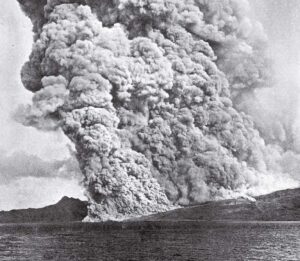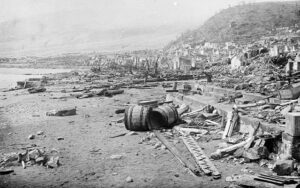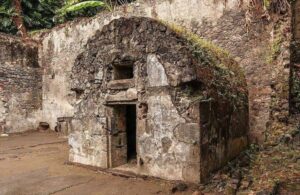 Anytime a volcano erupts, there is going to some degree of destruction, and most of the time, there is little notice. Some eruptions, however, bring more destruction and death that others. The eruption of Mount Pelée on the island of Martinique in the Caribbean on May 8, 1902, resulted in nearly 30,000 deaths and the destruction of the town of Saint Pierre. When the eruption occurred, the pyroclastic flow, also called a pyroclastic cloud, hit the town totally destroying it…or almost all of it. The city was virtually wiped off the map.
Anytime a volcano erupts, there is going to some degree of destruction, and most of the time, there is little notice. Some eruptions, however, bring more destruction and death that others. The eruption of Mount Pelée on the island of Martinique in the Caribbean on May 8, 1902, resulted in nearly 30,000 deaths and the destruction of the town of Saint Pierre. When the eruption occurred, the pyroclastic flow, also called a pyroclastic cloud, hit the town totally destroying it…or almost all of it. The city was virtually wiped off the map.
A prisoner, Ludger Sylbaris, who was born sometime around 1875. Sylbaris who used the aliases Auguste Ciparis, Joseph Surtout, and other names, was a convicted felon who had violated his parole. When he was captured, it was decided that he would be confined to an underground cell in Saint Pierre. As smoke filled the sky and lava made its way toward Saint Pierre, Sylbaris reportedly knew nothing of what was happening around him. Nevertheless, while he was right in the path of the destruction, his underground prison would end up protecting him while the rest of Saint Pierre was destroyed. The search for survivors consumed the rescue workers, and it wasn’t until four days after the city was destroyed that Sylbaris was found, half-conscious and burned.
The eruption of Mount Pelée began, or more correctly, it began to show signs on April 2, 1902. Mount Pelée,  which means bald in French, was a 4,500-foot mountain on the north side of the Caribbean Island of Martinique. On April 2nd, new steam vents were spotted on the peak, which overlooked the port city of Saint Pierre. Three weeks later, tremors were felt on the island and Mount Pelée belched up a cloud of ash. That was all the warning they had, but in 1902, they might not have realized just how grave their situation was. On May 7, activity on the volcano increased dramatically and the blasts grew significantly stronger. Overnight, there were several strong tremors and a cloud of gas with a temperature of more than 3,000 degrees Fahrenheit spilled out of the mountain. Finally, a tremendous blast in the early morning hours of May 8th sent a pyroclastic flow of boiling ash down the side of the mountain. By the time anyone realized they were in serious trouble, it was too late to get away, which is what caused the 30,000 deaths. It also left the prisoner, Sylbaris in an underground cell, with no one knowing that he was there. Only a thorough search of the area and the fact that he had been housed underground, saved his life.
which means bald in French, was a 4,500-foot mountain on the north side of the Caribbean Island of Martinique. On April 2nd, new steam vents were spotted on the peak, which overlooked the port city of Saint Pierre. Three weeks later, tremors were felt on the island and Mount Pelée belched up a cloud of ash. That was all the warning they had, but in 1902, they might not have realized just how grave their situation was. On May 7, activity on the volcano increased dramatically and the blasts grew significantly stronger. Overnight, there were several strong tremors and a cloud of gas with a temperature of more than 3,000 degrees Fahrenheit spilled out of the mountain. Finally, a tremendous blast in the early morning hours of May 8th sent a pyroclastic flow of boiling ash down the side of the mountain. By the time anyone realized they were in serious trouble, it was too late to get away, which is what caused the 30,000 deaths. It also left the prisoner, Sylbaris in an underground cell, with no one knowing that he was there. Only a thorough search of the area and the fact that he had been housed underground, saved his life.
In the end, it was determined that because they were caught up in the midst of an important election, the  residents of Saint Pierre failed to heed the mountain’s warnings and evacuate. They mistakenly believed that the only danger from the volcano was lava flow and assumed that if lava started to flow, they would have plenty of time to flee to safety. In fact, some people came from outside the city to view the action, even after ash from the eruption began to block roads. The city of Saint Pierre was buried within minutes and virtually everyone died instantly. There were only two reported survivors, one being Sylbaris, the prisoner held in an underground cell. In addition to the destruction of the city, 15 ships in the harbor were capsized by the eruption. One ship managed to stay afloat with half the crew surviving, although most suffered serious burns.
residents of Saint Pierre failed to heed the mountain’s warnings and evacuate. They mistakenly believed that the only danger from the volcano was lava flow and assumed that if lava started to flow, they would have plenty of time to flee to safety. In fact, some people came from outside the city to view the action, even after ash from the eruption began to block roads. The city of Saint Pierre was buried within minutes and virtually everyone died instantly. There were only two reported survivors, one being Sylbaris, the prisoner held in an underground cell. In addition to the destruction of the city, 15 ships in the harbor were capsized by the eruption. One ship managed to stay afloat with half the crew surviving, although most suffered serious burns.


Leave a Reply